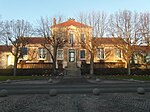Church of Saint-Julien-de-Brioude, Marolles-en-Brie
11th-century Roman Catholic church buildings in France12th-century Roman Catholic church buildings in FranceChurches in Val-de-MarneGothic architecture in FranceMonuments historiques of Île-de-France ... and 1 more
Romanesque architecture in France

The Church of Saint-Julien-de-Brioude is a Roman Catholic church located in Marolles-en-Brie in the Val-de-Marne department in France. It is dedicated to St. Julian of Brioude and became a Class Historic Monument in 1909.
Excerpt from the Wikipedia article Church of Saint-Julien-de-Brioude, Marolles-en-Brie (License: CC BY-SA 3.0, Authors, Images).Church of Saint-Julien-de-Brioude, Marolles-en-Brie
Rue Pierre Bezançon, Créteil
Geographical coordinates (GPS) Address External links Nearby Places Show on map
Geographical coordinates (GPS)
| Latitude | Longitude |
|---|---|
| N 48.732222222222 ° | E 2.5508333333333 ° |
Address
Église Saint-Julien de Brioude
Rue Pierre Bezançon
94440 Créteil
Ile-de-France, France
Open on Google Maps









